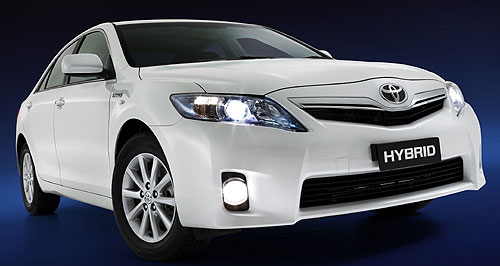Make / Model Search
Future models - Toyota - Camry - HybridCamry Hybrid cuts the dragNose first: The Camry Hybrid's redesigned front fascia contributes to its improved aerodynamics over the standard Camry. Toyota says aero tweaks make Camry Hybrid most slippery local car with 0.27Cd21 Dec 2009 A FLAT underbody and re-designed nose will help to make the upcoming Toyota Camry Hybrid the most aerodynamic Australian-built car with a drag co-efficient of just 0.27Cd, Toyota says. This figure is a six per cent improvement over the current Camry’s 0.28Cd, but short of Toyota’s other hybrid, the world-beating third-generation Prius which slips through the air with a drag of just 0.25Cd. Continuing its publicity drip-feed for the petrol-electric Camry ahead of its Australian sales launch in February, Toyota had its corporate manager of design Paul Beranger talk journalists through the styling changes for the new vehicle, which was fundamentally designed in Japan but with input from Toyota’s styling centres in Australia and the US. Mr Beranger said the changes centred on reducing drag while catering for the cooling requirements of the Toyota Hybrid Synergy Drive powertrain. He said a smaller upper grille was balanced with a larger lower opening in the bumper, improving air flow over the front of the car while ensuring sufficient cooling for the petrol engine and electric drive components. Flat sides on the bumpers reduced turbulence down the sides of the vehicle, while a flat underbody reduced drag while achieving negative lift.  The slippery body helps the Camry Hybrid achieve what Toyota claims will be Australia’s lowest fuel consumption for a locally-produced car. Although the company is yet to give an exact figure, it has hinted at a combined-cycle figure in the low 6.0 litres per 100km range, compared with the standard Camry's 8.8L/100km. The slippery body helps the Camry Hybrid achieve what Toyota claims will be Australia’s lowest fuel consumption for a locally-produced car. Although the company is yet to give an exact figure, it has hinted at a combined-cycle figure in the low 6.0 litres per 100km range, compared with the standard Camry's 8.8L/100km.Mr Beranger said research by Toyota’s Australian design house, Toyota Style Australia, revealed that aspiring hybrid car drivers wanted their vehicle to be distinctive, standing apart from regular petrol models. This influenced the Camry Hybrid design, with Prius-like styling cues adopted in items such as the blue-tinted headlamp covers and dashboard instruments and redesigned front fascia with satin chrome finish. A look in the boot revealed that luggage space is impacted by the nickel-metal-hydride battery pack which sits between the rear wheels, all but blocking the donor Camry’s opening created by the 60/40 fold-down seats. However, the designers at least managed to salvage a pass-through hatch, large enough to accommodate a surfboard. The rear placement of the battery pack – along with the regular lead-acid engine battery which is also in the the boot – helps to achieve a 50/50 weight distribution, Toyota says. Road noise was a challenge on a car shod with hard low-rolling resistance tyres. Mr Beranger said any noise was was accentuated by the quietness of the hybrid powertrain. “Due to the smooth, quiet EV (electric vehicle) operation, vehicle noise is more easily noticed than in conventional cars that use petrol or diesel engine as their main drive power,” he said. “Engineers drove the car in Australia and other countries to evaluate and analyse the resulting noise and vibration. “As a result, sound insulating and absorbing materials were placed in key areas to achieve the required level of quietness for Hybrid Camry.” Inside, the newest Camry gets hybrid-specific instrumentation, including an indicator that lights up with the word “ready” when the ignition is on, even though the 2.4-litre petrol engine remains off. An instant fuel-consumption meter indicates when the car is running on electricity or petrol. Full-scale production of the Camry Hybrid started at Toyota Australia’s Altona factory in Victoria last week. The company plans to sell 10,000 Camry Hybrids in the first year.  Read moreAll future models Alfa Romeo Alfa Romeo Abarth Abarth Alpine Alpine Alpina Alpina Audi Audi Aston Martin Aston Martin BMW BMW Bentley Bentley Chery Chery Brabham Brabham Chrysler Chrysler Chevrolet Chevrolet Cupra Cupra Citroen Citroen DS DS Dodge Dodge Fiat Fiat Ferrari Ferrari Foton Foton Ford Ford Great Wall Great Wall FPV FPV Haval Haval GWM GWM Honda Honda Holden Holden Hummer Hummer HSV HSV Infiniti Infiniti Hyundai Hyundai Jaguar Jaguar Isuzu Isuzu Kia Kia Jeep Jeep Land Rover Land Rover Lamborghini Lamborghini Lexus Lexus LDV LDV Mahindra Mahindra Lotus Lotus Mazda Mazda Maserati Maserati Mercedes-AMG Mercedes-AMG McLaren McLaren MG MG Mercedes-Benz Mercedes-Benz Mitsubishi Mitsubishi Mini Mini Opel Opel Nissan Nissan Peugeot Peugeot Pagani Pagani Proton Proton Porsche Porsche Renault Renault Ram Ram Rover Rover Rolls-Royce Rolls-Royce Skoda Skoda Saab Saab SsangYong SsangYong Smart Smart Suzuki Suzuki Subaru Subaru Toyota Toyota Tesla Tesla Volvo VolvoCamry pricing
Motor industry news |
Click to shareToyota modelsResearch Toyota All future models Alfa Romeo Alfa Romeo Abarth Abarth Alpine Alpine Alpina Alpina Audi Audi Aston Martin Aston Martin BMW BMW Bentley Bentley Chery Chery Brabham Brabham Chrysler Chrysler Chevrolet Chevrolet Cupra Cupra Citroen Citroen DS DS Dodge Dodge Fiat Fiat Ferrari Ferrari Foton Foton Ford Ford Great Wall Great Wall FPV FPV Haval Haval GWM GWM Honda Honda Holden Holden Hummer Hummer HSV HSV Infiniti Infiniti Hyundai Hyundai Jaguar Jaguar Isuzu Isuzu Kia Kia Jeep Jeep Land Rover Land Rover Lamborghini Lamborghini Lexus Lexus LDV LDV Mahindra Mahindra Lotus Lotus Mazda Mazda Maserati Maserati Mercedes-AMG Mercedes-AMG McLaren McLaren MG MG Mercedes-Benz Mercedes-Benz Mitsubishi Mitsubishi Mini Mini Opel Opel Nissan Nissan Peugeot Peugeot Pagani Pagani Proton Proton Porsche Porsche Renault Renault Ram Ram Rover Rover Rolls-Royce Rolls-Royce Skoda Skoda Saab Saab SsangYong SsangYong Smart Smart Suzuki Suzuki Subaru Subaru Toyota Toyota Tesla Tesla Volvo VolvoCamry pricing
Motor industry news |










Facebook Twitter Instagram